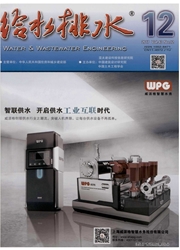

 中文摘要:
中文摘要:
考察了不排泥运行情况下膜生物反应器(MBR)中污泥活性的变化以及硝化菌群的分布情况。研究结果表明,在一年多的试验运行期间,反应器内污泥浓度逐渐增加,尽管进水水质波动,但出水水质比较稳定;随着运行时间的延续,污泥的活性有所变化,比耗氧速率从运行初始的18.3mgO2/(gVSS.h)减少至第314天时的8.63mgO2/(gVSS.h);在总细菌中活细菌的比例明显下降,而上清液中DNA的浓度没有明显增加。表明运行稳定后MBR污泥中的微生物大部分处于内源呼吸状态。采用NSO190和NSO1225两种探针探测了硝化菌群在不同污泥粒径中的分布,以分析不同粒径的污泥硝化活性。结果表明,粒径越小硝化菌群越密集,而相应的硝化速率也越快。
 英文摘要:
英文摘要:
This article presents an experimental study on the characteristics of the sludge activity in a membrane bioreactor(MBR)under non-discharge operation. The experimental results showed that during more than one year's operation,the MLSS in the MBR increased graduallyy,the effluent quality kept stable despite the fluctuation of the influent quality. The sludge activity changed over the operational period, as the specific oxygen consumption rates (SOUR)of the sludge decreased from 18.3 mgO2/(gVSS · h)in initial stage to 8. 63 mgO2/(gVSS · h)at the 314^th day. Furthermore, the percentage of active cells in overall bacteria decreased, despite the stable DNA concentration in the supernatant, indicating that most bacteria adopt endogenous respiration under stable operation condition. NSO190 and NSO1225 were used as probes to study the distribution of nitrifying bacteria communities in different granules and the sludge nitrification activity. The result indicates that there is a negative correlation between the granular size and the concentration of nitrification bacteria and the nitrification rate.
 同期刊论文项目
同期刊论文项目
 同项目期刊论文
同项目期刊论文
 期刊信息
期刊信息
